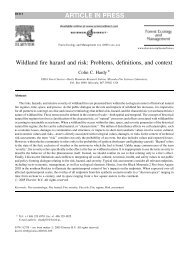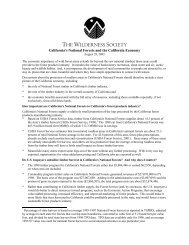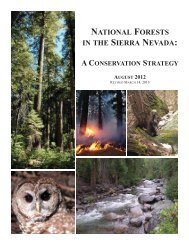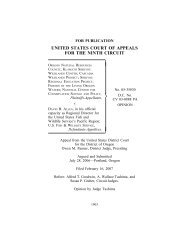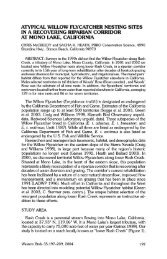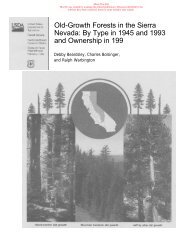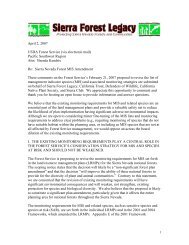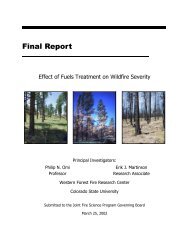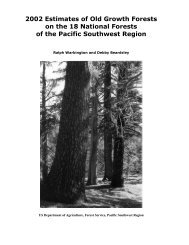Final report to - Sierra Forest Legacy
Final report to - Sierra Forest Legacy
Final report to - Sierra Forest Legacy
- No tags were found...
You also want an ePaper? Increase the reach of your titles
YUMPU automatically turns print PDFs into web optimized ePapers that Google loves.
1024VOLUME II, CHAPTER 36conditions at its location) (Chapel et al. 1992). For the <strong>Sierra</strong>Nevada, that height in many forest types is approximately 46m (150 ft). However, the incorporation of wood and otherorganic material in<strong>to</strong> streams will occur also during inundationof the floodplain. For larger streams in regions of gentlegradient, the width of a stream during major floods may extendmuch beyond 46 m.The Riparian Buffer AreaThe effects of land-use disturbance are reduced by keepingsuch activities at a distance from the aquatic system and bymaintaining a buffer area capable of absorbing disturbance.The likelihood of disturbance <strong>to</strong> a stream from most land usesincreases as a function of proximity <strong>to</strong> a stream, the steepnessof surrounding hillsides, and the erodibility of soils. Theserelationships, as in many risk fac<strong>to</strong>rs, are probably multiplicativeand therefore a doubling of slope has more than twicethe risk of disturbance <strong>to</strong> the stream (i.e., an exponentialchange). Current practice for designing buffer systems basedon risk rely on classification of the aquatic system (as wasmentioned earlier) and the creation of three or four categoriesof slope. As a consequence, a fixed width is chosen eventhough conditions on the land and requirements of the communitywould suggest a variable width (Bisson et al. 1987).We propose a more direct system for estimating a variablewidthbuffer system based on the community and energy areain combination with slope and other measurable risk fac<strong>to</strong>rs.For example, let us assume that a stream is in the mixedconifer zone. The determination of hillside slope can be madefrom <strong>to</strong>pographic maps or from GIS. The SNEP GIS team hasprepared a program that will calculate slope at 30 m (98.5 ft)increments along a stream channel. At each point, slope fromfive successive 30 m segments out from a channel are computedfrom the 30 m Digital Elevation Model. Slopes are thenweighted 5, 4, 3, 2, 1, from closest <strong>to</strong> farthest away, and dividedby 5 <strong>to</strong> produce a weighted average slope over the 150m (slopes closest <strong>to</strong> the stream have the greatest effect on theaverage). Let’s also assume that the stream has a communityarea defined by species as 110 ft (33.5 m) and an energy areathat is 150 ft (46 m). Thus, a minimum region with maintenanceof forest structure and minimal land disturbance is 150ft for these two areas. This distance is then multiplied by thebase of natural logs (e) raised <strong>to</strong> a power equal <strong>to</strong> 1+slope (indecimal form). If, for example, the slope were 25%, the equationwould beBuffer width (ft)=150 * e (1+0.25)giving a value of 524 ft (160 m). If the average slope were50%, the buffer would be 672 ft (205 m). In the first case, anadditional 374 ft (114 m) of buffer would be needed. Soil erodibility,also available from soil maps and GIS, can be incorporatedas the detachability value (see Costick 1996), and theexponent would be expanded <strong>to</strong> 1+slope+detachability –(slope * detachability). For example, if detachability were 0.30,the equation would beBuffer width (ft) = 150 * e (1+0.25+0.30–0.075)giving a value of 656 ft (200 m). Extreme cases, when slopeand detachability are both high, would result in even largerbuffer zones, and as slope and detachability approach zero,buffer zones would become smaller—exactly the outcomecommon sense would indicate is appropriate. This additionalarea beyond 150 ft would not have the same land-use restrictionsas the community and energy areas. Its purpose is <strong>to</strong>highlight a region in which probability of disturbance mayaffect the community or energy areas and the aquatic system.Silvicultural procedures should minimize soil disturbance andin general retain sufficient forest structure <strong>to</strong> ameliorate microclimatechange within the community area and minimizethe abrupt transition from the area upslope <strong>to</strong> the communityarea. Describing the buffer zone as a “probability of disturbanceregion” places the responsibility on managers fordesigning practices that have higher standards and are morecarefully matched <strong>to</strong> conditions where mistakes will mattermore.Current information and computer-aided analytic methodsare sufficient for layout of such a buffer system for manyregions of the <strong>Sierra</strong>. An example is shown in figure 36.7 thatillustrates a fixed buffer representing the energy area (150 ft)and the wider variable buffer area computed from the equationgiven earlier. Notice in the selected region along the NorthYuba River near the <strong>to</strong>wn of Downieville that State Highway49 lies within both areas for nearly all the distance illustrated.Stream channels in this case represent those modeled by GISbecause existing USGS maps omit many actual streams. Refinementsin scale of Digital Elevation Models from 30 m <strong>to</strong>10 m are underway, and soil mapping (for estimating soildetachability and other fac<strong>to</strong>rs) continues <strong>to</strong> expand and beincorporated in<strong>to</strong> GIS layers. Most forest and land managers<strong>to</strong>day could determine first approximations based on habitatrequirements, energy inputs, and hillside slope calculations<strong>to</strong> produce a logical, ecologically based riparian managementprotectionsystem along these lines. It would lead <strong>to</strong> betterprotection of riparian-dependent organisms and of energylinkages between the land-water systems, and would assistmanagers in tailoring land-use activities <strong>to</strong> regions of greaterneed than is presently the case.Riparian Maintenance FlowsThe interrelations between physical channel processes andriparian vegetation are only now becoming better unders<strong>to</strong>od,and in any event the precise nature of these interrelationsvaries from river <strong>to</strong> river. Thus, specifying riparian maintenanceflows (or “channel maintenance” or “flushing”) can beviewed as essentially experimental at present.To evaluate the effectiveness of riparian maintenance flows



